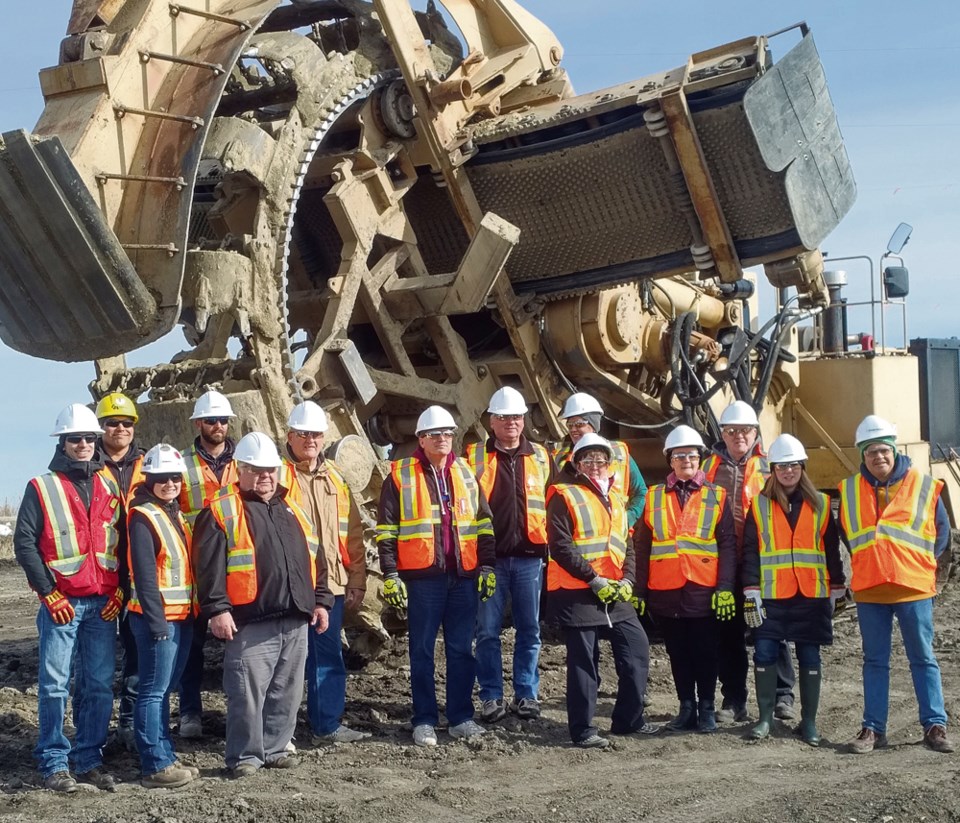Muddy boots were the trademark of a tour in southern Manitoba to discover more about the largest project in Enbridge history, Line 3 replacement and the oil industry that employs spouses, children, family members, friends and neighbours either directly or indirectly; and has done since the 1940s.
Out of the Calgary office, Enbridge officials met with a motley crew for an up close and personal look at pipeline being laid in “Spread 8”, south-east of Brandon.
The trip took a handful of municipal officials, landowners, newspaper reporters/photographers from our meeting place in Wawanesa Hall, down Hwy 2 past Glenboro, past Holland, south through Swan Lake First Nation, until we were surrounded by the giant wind turbines of the St. Leon wind farm on a right-of-way where segments of pipe were being welded together.
Joanne Bradbury, Community Engagement portfolio, David Coll in Communications and Assistant Construction Manager Mike Jespersen were tour hosts.
On tour were, Pat Cochrane and Marya Gardiner from the RM of Sifton, Darren Myers, CAO for Municipality of Glenboro-South Cypress, Mayor of Glenboro Earl Malyon and Councillor Eric Plaetinck (Deputy Mayor), along with reporters and photographers.
Unusual bus tour
Largely invisible, one of Canada’s chief resources makes its way across the prairies, underground, at a slow jog.
The fact that a pipe segment 66 feet long and worth about $18,000 receives five welds, a special epoxy paint coating and numerous inspections, was part of the interesting details.
Bradbury was an engaging host. She explained, “Line 3 was built in 1968 to the highest standard of the day. Tape coating was one of those standards. Unfortunately, that coating is not standing up to time.”
That’s why the pipe laid in 1968 is being decommissioned and replaced with brand new pipe – safety and efficiency.
Line 3 Replacement Program will fully replace 1,660 kilometres with new pipeline and associated facilities on either side of the Canada-U.S. border.
By mid to late 2019 the new pipe is expected to be in service, carrying batched product: light, medium and select heavy crude oil between Hardisty (Edmonton) and Superior Wisconsin.
A quiet ghost
Old Line 3 will be decommissioned, in place, not torn out.
Enbridge has seven pipelines in the mainline corridor through the prairies: Lines 1, 2, 3, 4, 13, 65 and 67 known as the Alberta Clipper.
Bradbury explained, “Removing Line 3 is not the best idea. There’s a certain integrity and stability that we want to maintain in the mainline system, so we have chosen to decommission in place.”
The pipeline is cleaned, valves are removed, and the pipe is segmented off so it cannot become a conduit for groundwater. This decommissioned line will continue to be monitored as it remains Enbridge’s responsibility.
The Canadian Association of Energy and Pipeline Landowner Associations has commissioned a study at the University of Calgary. Bradbury says they are “looking at what happens with a pipeline over 50 years, 100 years, 500 years, a thousand years, so we understand what we should be looking for - what happens with the environment, topography and how that may affect a decommissioned pipeline.”
(to be continued next week)




